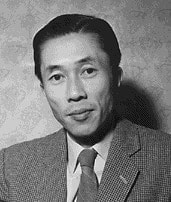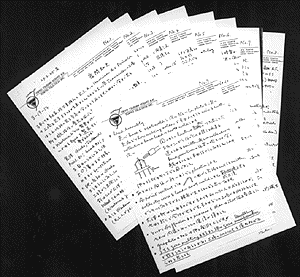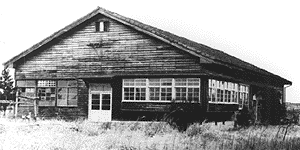Chapter5 "Rest Assured We Can Make It!"
"Rest Assured We Can Make It!"
 Kazuo Iwama greatly
Kazuo Iwama greatly contributed to the
development of transistors.
"Let's make radios," Ibuka replied.
"As long as we're going to produce transistors, let's make them for a product that anyone can afford to buy. Otherwise we'll be wasting our time. What I have in mind is a radio. Let's work on a transistor radio from the beginning, regardless of any difficulties we may face," stressed Ibuka. At that time even in the U.S. the only transistors available were low-frequency ones which could best be used in hearing aids or similar types of items. Ibuka's idea was a bold one, but he was full of confidence. "I am sure that we can produce transistors for radios." Fired by Ibuka's confidence, the Totsuko engineering staff accepted the challenge.
For these engineers, the greater the challenge, the greater their reward. Still some at Totsuko were anxious and questioned the merit of risking the future of the company on the unproven transistor.
Outsiders were even more skeptical. In fact, a majority thought that it would be an impossible venture for a small company like Totsuko to make a transistor radio, which even American companies could not produce. NHK's Shigeo Shima felt the same way.
"We are going to produce transistors at our company. We'll make radios with them," Ibuka said to Shima proudly. "Transistor radios? Are you sure? Even in the U.S. transistors are used only for defense purposes where money is no object. Even if you come out with a consumer product using transistors, who can afford to buy a machine with such expensive devices?" Shima warned Ibuka out of genuine concern for his old friend. "That's what people think. It is true that the production yield of transistors is very low at this stage, 5% at most even in the U.S. People are saying that transistors won't be commercially viable. But I disagree. This will make an interesting business all the more because yield is low, for we can always improve production yield," Ibuka reasoned somewhat vehemently. Shima was convinced, but when Ibuka went to MITI again, they were not.
"Actually, we have already obtained a license from Western Electric. So we earnestly ask for your approval." But MITI officials were incensed saying, "It's inexcusable that you signed a contract without our permission!" Totsuko had no choice and did what could be done under the circumstances while waiting for MITI's move. A transistor development task force was formed immediately with the most capable staff. Kazuo Iwama, general manager of tape recorder production, volunteered to head this team. Physicists Tetsuo Tsukamoto and Saburo Iwata, mechanical engineer Sukemi Akanabe, chemical expert Akio Amaya, electrical engineer Junichi Yasuda, and others from various fields joined together to work on the project with Iwama.
Before they could make a radio, they had to produce a high-frequency transistor. But Totsuko had virtually no research material to go on, let alone production know-how. The only reference book that was available was Transistor Technology (regarded as the 'transistor bible'), which Morita had brought back from the United States. With this book in hand, Iwama and his team began their research.
Toward the end of 1953, MITI had a shakeup of its personnel in charge of the electronics industry. As a result, things took a sudden turn in favor of Totsuko, and the prospect of obtaining MITI's approval for transistor production brightened. At the beginning of January 1954, Iwama went to the U.S. to learn about transistors. Later that month Ibuka joined him and visited Western Electric's transistor plant with him. This gave Totsuko the foundation it needed to work on the transistor.
The Iwama Reports
 Letters sent by Kazuo Iwama
Letters sent by Kazuo Iwama from the United States in 1954.
When he went to Western Electric to study transistors, the 35-year old Iwama was just entering his prime. But this does not entirely account for the tremendous energy with which he threw himself into his work.
Iwama's knowledge of transistors was limited to the little he had acquired on manufacturing basics from Transistor Technology. Above all, he had to take back to Japan as much information as he could. Western Electric would not provide specifications for the manufacturing equipment, but they were happy to show him around their factories. On these tours Iwama would stop in front of each item that seemed particularly interesting and ask questions in his not too perfect English. He took down the answers and included his impressions in the reports to Tokyo. Being unable to make diagrams on the spot, he would return to the hotel and test his memory for every detail of what he had seen and heard, and while his reports may not have been totally accurate, they were certainly exhaustive. The first ran to nine oversized pages, eight more on February 19, nine more on February 21, five on April 7, another five on April 9, eight on April 13, and four on April 15. Though he did not write every day, his output was prodigious.
Based on Iwama's reports and Transistor Technology, his colleagues in Tokyo set about making a transistor of their own for Iwama to see when he returned. The first hurdle was to construct the necessary machine tools. Naturally there were none on the market for use in manufacturing semiconductors. And no matter how carefully they read Transistor Technology, the diagrams they needed could not be found there. They had no choice but to draft their own blueprints for every single piece of equipment. Akanabe started to do so, guided by suggestions from Iwata, Tsukamoto and others. But all he had to work with in the Totsuko machine shop were two small lathes, a drill press, and a milling machine -a real shoestring operation! There was no way the work could be completed on the premises, and so the machining was leased to a subcontractor. Starting from scratch, the task force devised a germanium oxide reductor using hydrogen, a zone refining slicing machine which raises the purity !! of the product and related apparatus.
Totsuko's own transistor oscillated for the first time one week before Iwama was due back from the U.S. It was of the point-contact type created by Shockley and his team at Bell Laboratories. The oscillator was hand-made by Yasuda.
The first flicker of the needle was greeted with an outburst of joy. No one had expected to see a transistor finished so soon. A junction-type device followed so quickly that even Iwama, back in Japan by then, could not believe it. When shown the germanium crystals, he was not at all convinced that they were the real thing. In fact, it was not until he saw the oscillator swing its needle that he knew they had done it. It did indeed seem to be a transistor.
Staking Sony's Future on Transistors
It had been a bold move. When Masaru Ibuka and Akio Morita decided to go into transistors, Totsuko had been in business a mere six years. Though quite well-known in the tape recorder field, the company was still capitalized at under 100 million yen. Embarking on such an uncertain venture, Totsuko in vested funds and effort on a scale almost unthinkable for a company of its small size.
The transistor project cost money. To raise funds for research and development, Toshiro Sakota, head of Totsuko's Accounting Department, went to the Credit Division of the Mitsui Bank. The bank was openly skeptical, saying, "These transistors, they're just substitutes for vacuum tubes, aren't they?" In postwar parlance, "substitute" meant a stopgap imitation made to fill a shortage of the genuine article. For instance, staple fiber and rayon were considered substitutes for cotton and silk respectively. No matter how many assurances the bank was given that this product was entirely different from a vacuum tube, the distinction fell on deaf ears. Finally the accountant had to bring Ibuka along to do the talking.
Ibuka's explanation was extremely reasonable: "Any action is accompa nied by friction. Friction wears away the material. This wear causes breakdowns. In the transistor, the action involves no moving parts. A transistor achieves the same effect as a vacuum tube through molecular changes. Therefore, it is trouble-free. A transistor is a great deal smaller than a vacuum tube, with a simpler structure and solid build. It is a completely different proposition." He held them spellbound for nearly three hours and managed at last to win the Credit Division over.
An alloy-type junction transistor was ready about the time Kazuo Iwama returned from the U.S. Once work reached this point, it was past the stage of basic research; now the target was a transistor for use in radios. This was a problem of a different order. Aiming for a transistor that would operate at higher frequencies (ie., the grown type), they began making the devices they would need if they were to replace their semi-manual operations which relied partiallyon human skill - the pulling, wrapping, and so on- with an automated process for greater precision.
License Agreement of Ferrite
 Ibuka proudly showing the machine used for
Ibuka proudly showing the machine used for the production of transistors.
The first G-type tape recorder, marketed by Totsuko in 1950, had lost much material from theerasing head, and this was holding back any improvement in its performance.Ibuka's people looked into using ferrite, a magnetic materialwith good high-frequency characteristics, to manufacture the head. In 1951 they began a joint research project with Tohoku University's Okamura Laboratory, a pioneer of ferrite research in Japan. Totsuko sent Masaaki Morita, Akio's younger brother, to work with Professor Toshihiko Okamura, while in their own laboratory Iwama's team continued to develop the ferrite head.
Tohoku University's Okamura Laboratory had been conducting research on ferrite, assisted by grants from Tohoku Metal Industries, a member of the Sumitomo group, and Totsuko. In 1953, Okamura happened to discover a form of ferrite which promised to be commercially viable and he registered apatent.
Due to a heart ailment, however, Okamura was in no condition to negotiate licensing agreements with commercial firms. Acting on his behalf, Takasaki had gone first to Tohoku Metal Industries, which had put up the larger share of the funding. The company expressed their willingness to discuss patent royalties: "We'll get back to you," they said. Takasaki waited, but the answer was slow in coming. He paid a second visit, but was only told, "We'll consider it." Still there was no firm answer.
He then went to Totsuko, where for twenty or thirty minutes he was quizzed by Ibuka and Morita. "The royalty is very high, isn't it?" Ibuka said as they were about to part. Takasaki explained, citing the major patents owned by the Research Institute of Metallurgy, that the royalty rates for materials were higher than those for manufactured sets. "All right, then. Please see our research director and his team." Ibuka thus referred him to Iwama and the others who would be actually dealing with the material, and they cross-examined Takasaki for three hours.
Even Takasaki was dismayed at what sticklers these people were. About the time they were running out of questions, Ibuka, who had left them to it until then, joined Iwama and his colleagues. "Well?" he inquired. "We've covered everything," came the answer.
"Then, Mr. Takasaki, we're ready to sign." Ibuka made it sound very simple. He would press his seal to the agreement as drafted. Takasaki was astounded by the sharp contrast between their attitude and that of Tohoku Metal Industries.
The Sendai Plant Opens
In mid-July, a month after Takasaki's visit, Morita traveled to Sendai. "We've signed, but we don't have the personnel. Will you do the job?" he asked Takasaki. "For the sake of Totsuko's future, we must have a materials plant. It can be anywhere in Japan you like." Takasaki was tempted, but he did not give his reply at once. Then in August he had a phone call from Ibuka, asking to come see him.
Takasaki happened to have business in Tokyo when Ibuka called, so they agreed to meet. He had thought for some time that the company looked interes ting. Succumbing to Ibuka's persuasiveness, he decided to give it a try.
 The Sendai plant was built on farmland.
The Sendai plant was built on farmland.In those days, the Miyagi prefectural government actively encouraged factories to locate there. It was part of a grand scheme to create an industrial belt, known as the Senen Industrial Area, extending from the war-devastated city of Sendai, with its consumer-oriented economy, to the fishing port of Shiogama. From Totsuko's point of view, the conditions there were ideal. The greatest advantage was its proximity to Tohoku University, with whose scientists the company had collaborated closely in joint research projects on ferrite, tape, etc. Other factors behind the move to Sendai were the ample supply of electricity, for which there were few large industrial users as yet in the Tohoku area (the supply in Tokyo was extremely inadequate), and the fact that Totsuko's main Gotenyama plant was outgrowing its capacity due to the increasing production quantity of tape recorders.
Takasaki began preparations for the plant at once. In February 1954 he set up a temporary office in a corner of the Sendai office of Yamato Shoji, who was then a Totsuko distributor. The project got under way with a staff of only six, counting the factory manager and a secretary. Under the Miyagi Prefecture Factory Location Ordinance No.1, they could have use of a 17,000-square-meter site in Tagajo rent-free for five years and the doctor's rooms of the old Imperial Navy Arsenal. Work began on remodelling the building.
On May 1 work was completed and the first step toward establishing the plant was taken. The duties of that first working day consisted of weeding,sweeping, washing windows and unpacking. The staff, now numbering 27, was truly starting from scratch. Their next task was the purchase of 27 pairs of rubber boots. The factory was surrounded on all sides by fields, some of which were flooded rice paddies. The roads were at best footpaths between fields. At night it was pitch dark, and one false step would land them in muddy water. When the plant came into full operation in June, neighbors in those rustic parts were astonished at the brightness of its fluorescent lights.
While Iwama and his team were working like men possessed on developing a transistor suitable for radios, the Totsuko sign was going up in the far-off Tohoku region. The Sendai plant opened for business.

